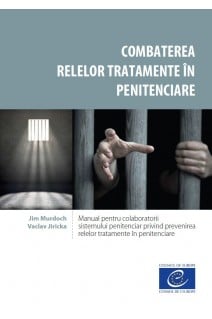



A handbook for prison staff with focus on the prevention of ill-treatment in prison
The handbook is designed for practitioners working in prisons. It examines one particular aspect of the protection of prisoners’ human rights: the prohibition of ill-treatment in prison. It is conceived as a policy guide and a management tool for professionals and it focuses upon what this prohibition entails and the responsibilities of prison services towards those entrusted to its care. The text highlights the relevant standards of the Committee of Ministers of the Council of Europe Recommendations and of the European Committee for the Prevention of Torture and Inhuman or Degrading Treatment or Punishment (CPT), and the case law of the European Court of Human Rights.
The handbook is a result of a multilateral meeting on combating ill-treatment in prison, held in Strasbourg in April 2015, as part of the Council of Europe co-operation activities in the penitentiary field implemented by the Criminal Law Co-operation Unit.
Table of Contents
LIST OF ABBREVIATIONS
INTRODUCTION THE FOCUS ON THE PREVENTION OF ILL-TREATMENT IN PRISON
CHAPTER 1: EUROPEAN STANDARD-SETTING
1.1 Introduction
1.2 The European system for the protection of persons deprived of their liberty
1.2.1 Legal obligations under the European Convention on Human Rights
1.2.2 Standard-setting by the CPT
1.2.3 The work of the Committee of Ministers of the Council of Europe
1.2.4 Other standard-setting and monitoring bodies
Conclusion
CHAPTER 2: PROTECTING PRISONERS - BASIC RESPONSIBILITIES: PROTECTING PRISONERS FROM PHYSICAL AND PSYCHOLOGICAL HARM
2.1 Introduction
2.2 Key guarantees of the European Convention on Human Rights
2.2.1 Operational activities in prisons and the right to life
2.2.2 The prohibition against torture and ill-treatment
2.2.3 Material conditions of detention
2.2.4 Inter-prisoner violence
2.2.5 Prisoners and the right to life – protection against self-harm and suicide
2.3 Preventing ill-treatment: health services in prison
2.3.1 Responding to the healthcare needs of individual prisoners who are particularly vulnerable
Conclusion
CHAPTER 3: RISK ASSESSMENT
3.1 Introduction
3.2 Assessing an individual’s security risk
3.2.1 Risk of re-offending
3.2.2 Static and dynamic risk factors
3.3 Principles of effective interventions
3.4 Risk assessment instruments
3.5 Some formal aspects of risk assessment implementation
CHAPTER 4: DYNAMIC SECURITY
4.1 Introduction
4.2 The principles of “dynamic security”
CHAPTER 5: DEALING WITH VULNERABLE GROUPS OF PRISONERS
5.1 Introduction
5.2 Juveniles
5.3 Prisoners with mental disabilities
5.4 Older prisoners and prisoners with physical disabilities
5.5 Ethnic, racial and religious minorities
5.6 Foreign national prisoners
5.7 Sexual minorities
5.8 Other vulnerable groups of adult prisoners
CHAPTER 6: SECURITY MEASURES, INSTRUMENTS OF RESTRAINT AND SOLITARY CONFINEMENT
6.1 Introduction
6.2 Strip-searching of prisoners
6.3 Security monitoring arrangements in prisons
6.4 Use of forcible restraints
6.5 Imposition of solitary confinement
6.6 Disciplinary procedures
CHAPTER 7: STAFFING ISSUES
7.1 Introduction
7.2 Staff selection, training and conditions of employment
7.3 Adequate staffing levels
7.4 Statements of ethics
CHAPTER 8: COMPLAINTS, INSPECTIONS AND THE DUTY TO INVESTIGATE
8.1 Introduction
8.2 Complaints and inspection mechanisms
8.3 The duty to investigate
Conclusion
REFERENCES
Judgments and decisions of the European Court of Human Rights





A handbook for prison staff with focus on the prevention of ill-treatment in prison
The handbook is designed for practitioners working in prisons. It examines one particular aspect of the protection of prisoners’ human rights: the prohibition of ill-treatment in prison. It is conceived as a policy guide and a management tool for professionals and it focuses upon what this prohibition entails and the responsibilities of prison services towards those entrusted to its care. The text highlights the relevant standards of the Committee of Ministers of the Council of Europe Recommendations and of the European Committee for the Prevention of Torture and Inhuman or Degrading Treatment or Punishment (CPT), and the case law of the European Court of Human Rights.
The handbook is a result of a multilateral meeting on combating ill-treatment in prison, held in Strasbourg in April 2015, as part of the Council of Europe co-operation activities in the penitentiary field implemented by the Criminal Law Co-operation Unit.
Attention, en vertu de nos conditions générales de vente, l'achat des PDF/epub est réservé aux particuliers.
